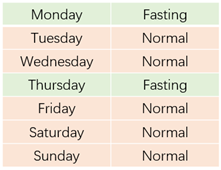5:2 intermittent fasting has become one of the most popular fasting plans for those who’d like to lose weight quickly and healthily, which is especially true after Jimmy Kimmel shared his 25-pound loss diet plan and Gisele Bündchen told her diet trick to stay in shape.
Do you want to lose weight in a healthy and easy way? To have normal meals for 5 days and fast for 2 days a week? It sounds excited, right? However, before kicking off the ball, you should know what is 5:2 intermittent fasting and how to check it’s right for you or not.
What is 5:2 Intermittent Fasting?
The 5:2 intermittent fasting plan, also called The Fast Diet, allows fasters to have normal meals for 5 days a week and fast for the other 2 days. On the two fast days, the calorie intake should be limited to 500 calories for women and 600 calories for men.
As a lifestyle, the 5:2 intermittent fasting has been around for centuries but it attracted public attention due to the book The Fast Diet that was published in 2012 by Dr. Michael Mosley is a former medical doctor, health writer and BBC presenter having written a number of bestsellers about personal health and medicine.
Health Benefits of 5:2 Intermittent Fasting
First of all, 5:2 diet plan is a type of intermittent fasting plans, so the benefits of intermittent fasting also work for 5:2 diet plan and it also has some benefits compatible with it only.
Weight Loss
Weight loss is basically the essential aim of majority of people sticking to intermittent fasting and it will never let you down.
The two days of fasting a week limits fasters to calorie intake of 500 to 600 calories per day and are beneficial for people to lose weight. The two days of fasting can help you to reduce the intake of about 3,000 calories, which means an average 1 pound of weight can be lost per week if you stick to 5:2 diet plan. However, you should be reminded that if you compensate on the 5 normal diet days, the target won’t be achieved.
To eat as you like doesn’t mean you can eat as much as you can. If you pick up junk food only, the fasting days won’t make any sense.
Healthy Body
Intermittent fasting is studied to be beneficial to reduce insulin resistance, decrease inflammation and improve blood lipids. Moreover, intermittent fasting can reduce the risk of some disease since it clears away the waste in your body.
Expand Life
Based on the Honoring Clive McCay and 75 Years of Calorie Restriction Research by Roger B. McDonald and Jon J. Ramsey, a conclusion that rats with severely restricted diets lived up to 33% longer has been known. Therefore, a limit on calorie intake is beneficial to expand people’s lifespan, which is also where intermittent fasting stands.
As early as 1945, it was found out that fasting can expand rats’ lifespan. And this research further moves such a benefit of intermittent fasting to humans.
May Reduce the Risk of Cancer.
This benefit hasn’t been solidly determined since there aren’t a lot of research or experiments leading to the straight correlation between cancer and fasting. However, early studies look active.
This case series report testifies that the side effects of chemotherapy can be reduced if intermittent fasting is done before that.
Boost Focus and Thinking.
Apart from weight loss and body health, some research indicates intermittent fasting boosts focus and memory. Breaking snacking habits is beneficial to focus on the work, which is one of the essential advantages of intermittent fasting.
Easy to Follow
Compared to other types of intermittent fasting plans, 16:8 for example, the 5:2 diet plan is easier to follow.
You can choose any 2 days in a week for fasting and they can be alternated at any time as long as two days of fasting are achieved per week. Moreover, the 500 to 600 calories intake restriction sounds not difficult to conform to. In addition, five days with normal meals are with less pressure for people who want to lose weight.
How to Schedule Your Days in a Week based on 5:2 Diet Plan?
Based on the 5:2 protocol, you are allowed to eat normal meals for 5 days a week but it doesn’t mean you should eat more than what you eat on average. When you conform to the 5:2 diet plan, you should avoid intaking too many calories from the 5 days with normal meals. If you crazily compensate for the calories you “lose” during the fasting days, your weight won’t be lost. Worse still, if you intake too much food with high energy and sugar or highly processed food, your weight will be still gained.
If you don’t have a habit of calories calculation, then it’s suggested to do that now. To achieve the goal of 500 to 600 calories intake a day, you should cut the calories to 25% of your normal meal. To arrange the 500 calories in a day with three meals, for example, you can intake 100 calories for breakfast and 200 calories for your lunch and dinner respectively. Or, you can intake 250 calories for both lunch and dinner with 2 meals a day.
When it comes to the days schedule in a week, you can keep them based on your lifestyle. A commonly used 5:2 intermittent fasting schedule goes like this:

How and What to Eat on the 2 Days of Fasting?
On the two days of fasting with the 5:2 fasting plan, you have two options to arrange your diet:
- Have 3 small meals a day: breakfast, lunch and dinner
- Have 2 relatively big meals a day: lunch and dinner
When it comes to the food types you should take, try to intake the foods with rich nutrients, high fiber and proteins because they can make you feel full to stop you intaking too many calories, including:
- Fresh vegetables and fruit
Fresh vegetables and fruits are rich in fiber and nutrients like vitamins and they are hydrated, beneficial to lose weight.
- Greek yoghurt without sugar
- Whole Grains
Whole grains are rich in fiber and nutrients, making you feel full. Carbohydrates are good for brains so whole-grain bread, pasta, etc. play a major role in the 5:2 diet plan.
- Healthy fat
The foods with healthy fat include nuts, seeds, olive oil, avocado and sea fish that contain high content of omega-3 that is beneficial for brain.

- High fiber food
High-fiber foods make you feel full and provide nutrients to your body so that you can lose your weight in a healthy way.
- Soup
- Lean proteins
Chicken breast, turkey, eggs and fish provide continuous energy and proteins that boost muscle building and cell repairing. They can be eaten to improve your health.
- Black coffee
- Tea
- Pure water or other healthy beverages without sugar like lemon water
On the other hand, you should avoid:
- Beverages with sweetener or sugar
- Junk food
- Highly processed foods
Side Effects of 5:2 Intermittent Fasting
If you are an intermittent fasting beginner, you might come across side effects once you begin intermittent fasting. The side effects include:
- Fatigue
- Headache
- Irritation
- Hunger
- Drowsiness
- Mood swing
- Nausea
- Weakness
Don’t worry. The side effects are temporary and slight and they will disappear once your body has got used to intermittent fasting. If you suffer from severe side effects, however, you should go for your doctor’s advice.
If you feel hungry or irritating, you can try the following solutions to make you feel better:
- Drink more water
- Snap
- Busy with job things
- Take a rest
- Take a shower
- Stay with your friend
Who isn’t Fit for 5:2 Intermittent Fasting?
Although intermittent fasting is beneficial for people’s health, it doesn’t fit for everyone.
Some people should avoid 5:2 fast diet or even intermittent fasting no matter which plan:
- Individuals with a history of diet disorders
- Individuals with blood sugar drops
- Pregnant women and nursing mothers
- Teenagers and children
- Type 1 diabetes
- People who are malnourished, underweight, or known to have nutritional deficiencies
- Women who are trying to conceive or have fertility problems.
FOLLOW US
.png)